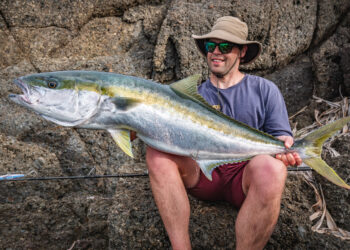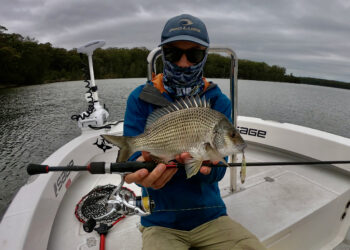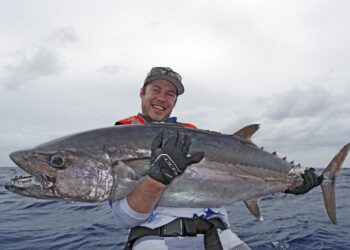
Trailers are often overlooked when buying a boat, and as Nathan Bajada explains, that could be a costly mistake.
There’s no point buying the best boat and engine if it sits on a bad trailer. The trailer is what gets your boat to and from the water in one piece, so it’s rather important! Poorly maintained or designed trailers are the cause of so many disastrous starts or finishes to a day’s fishing.
Trailers these day mainly come in steel with a hot dipped galvanised finish, however the trend of late has been to build them from aluminium. I’m a fan of aluminium as it reduces the overall weight of the towing package. It’s also less prone to corrosion and therefore lasts longer.
So, if you’re buying a second hand boat there’s a few things to check…

Springs and axles
These are usually some of the first components to corrode and fail. Either one of these failing will end your day as quickly as it began, not only this, they also have the potential to be very dangerous. An obvious sign of springs and axles that require attention is rust. If you are seeing this on the springs, axels or bolts holding it all together, they are going to need some attention.
Brake rotors and brake callipers
These are again components that are commonly overlooked. Whilst these can be made from stainless steel, the more common material is mild steel with a galvanised coating which rusts quickly. Depending on the size and weight of your boat you may have one of two types of braking systems. Smaller lighter boats usually have what’s known as a mechanical override braking system.
This is a simple cable operated braking system. These use a cable connected to the tow hitch that slides forward with inertia as you brake to pull pressure on the brake pads inside the callipers. These work okay when the brake rotors are in good condition and the cable is frequently adjusted, however, often the maintenance of this braking system is overlooked and they actually do very little.
For larger, heavier boats road regulations require a system known as electric over hydraulic braking system with a break-away feature. These trailers have brakes on each wheel and on all axels. They use a small battery powered hydraulic pump to operate the brake callipers, much like your car. These far out perform the basic over-ride cable systems and in most instances when the braking sensitivity is adjusted correctly they will stop the boat and car better than the car can stop by itself without the boat on the back.
They’re impressive, however with this comes higher amounts of heat transferred to all the braking components and wheel bearings, all of which tend to accelerate wear and corrosion. Generally these need more maintenance and in NSW need to be inspected by a heavy vehicle checking station. The break-away component ensures should the boat become de-coupled from the tow vehicle the trailer brakes are applied automatically and the boat will come to an emergency stop without assistance from the tow vehicle.
Bearings
These are some of the common types of bearing systems available on the market. I’ve used just about all of them and you may be surprised to hear what I’ve found to be the most reliable.
The most common system you may have heard about are Bearing Buddies, a device that replaces the basic steel cap on the outside of the hub. This enables the owner to pump grease into the hub using a grease gun.
Another is called the Dura Hub. These use thick oil rather than grease to lubricate and cool the bearings. Whilst I’m sure there are success stories and some have a preference over others I’ve found Bearing Buddies problematic due to people pumping too much grease into them, in turn pushing the hub seal out, or they have a tendency to let water in.

The oil type hub systems I’ve found to be generally better than the Bearing Buddies, however let me tell you, if some shifty bugger discovers your fancy bearing hubs during an overnight fishing mission and decides they’d look better on his trailer than yours, you are up the preverbal. All the oil usually retained by the outer hub cover will drain from your bearings, allow water in and I’m sure you can work out what comes next!
After trying all types of systems including the previously mentioned, I and many others I know have gone back to a basic steel cap filled with grease in place of any fancy hub system. We Sikaflex that cap in place and do the same to the rear axel seal. This has worked for us season after season.
At the end of the day regardless of what bearing system you choose to run, you need to be on top of them and frequently check them. I like walking around the trailer once we get to our destination and physically feeling the temp of each of our hubs. This is a great early indication of a potential issue. You very quickly learn what a normal hub temperature feels like, it will be warm to touch, but not so hot you can’t keep you hand on it for less than say 5-10 seconds. Assuming of course you haven’t just come to a quick stop and all the heat from the brakes has transferred through to the hub. If the hubs are an even temperature chances are things are going okay.
Another sign would be excessive grease in, around or flicked up onto the underside of the hull. If you are seeing this, it’s cause for concern and worth looking into, as the rear axle seal has leaked. If it can’t keep grease in, it sure can’t keep water out! You should aim to service your bearings at least once a year.
When buying a new trailer, assuming it’s with a new boat from the same dealer, ask around and see how well others that have bought that trailer package have found its performance. Being a competitive market you may not necessarily get the best trailer in these types of package deals. It can pay to do the research and if needs be buy the trailer separately. There are some pretty neat trailers available today and specialised manufacturers that really put the time into the design and setup of their trailers. They may have setup a trailer to suit your hull and know what does or doesn’t work.
They should know how to setup your rollers or skids to optimise the alignment and support of the boat. Some boat manufactures are building their own trailers, or aligning with trailer manufactures in join venture type arrangements, sharing 3D model designs of boat hulls and using this to correctly design and setup trailers. These are usually a good option to go with. If you can afford stainless steel components such as the springs, brakes callipers and pads you will get many years of trouble-free service.
You will hear the term, drive-on/off used around the ramp to describe a trailer. This means a trailer that can have the boat driven onto or off the trailer without the need to use a winch. For me this is a must have ability especially with heavier boats. When factoring this in, the set-up and configuration of the trailer is paramount. Nothing worse than having a trailer that won’t self-align or centre the boat as it comes up the trailer.

The trend to have trailers without rollers is gaining momentum. Full multi-roller trailers have their positives however in my experience can tend to cause more headaches compared to a trailer made of skids or maybe a combination of both. Rollers need maintaining and regular inspection. Pivoting mounts have a habit of seizing up or in some cases flipping over on themselves.
This is a disaster if you don’t notice this and try driving up the trailer, almost always ending up in a spray of choice profanities from the skipper and sometimes damage to the boats hull. If you’re in a position to set-up a new trailer try and use as few rollers as possible and favour Teflon covered planks or skids. The last thing anyone needs after a long day at sea is a trailer with attitude.
A feature that’s proving very popular and rightfully so is the auto release and catch devices on the market. A few of the common types are known as the Boat Catch, Boat Latch and Bar Crusher boats have their own deign called the Bar Catch. For more information on these devices see my article here.
Like any new purchase you can learn a lot by asking questions, doing your research and trying before you buy a trailer. Considering the trailer is what carries your pride and joy it’s another acquisition you don’t want to compromise on.
















